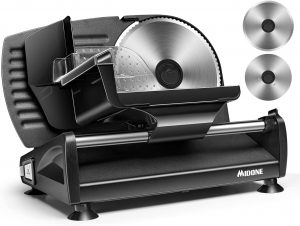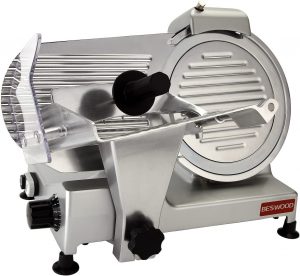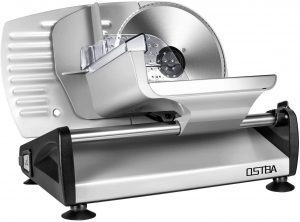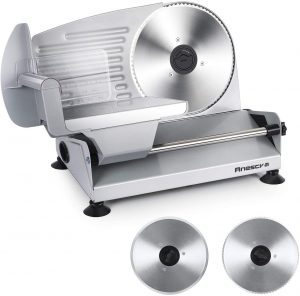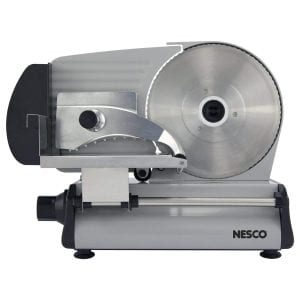Portion With Ease Using The Best Meat Slicer
We looked at the top 15 Meat Slicers and dug through the reviews from 93 of the most popular review sites including and more. The result is a ranking of the best Meat Slicers.
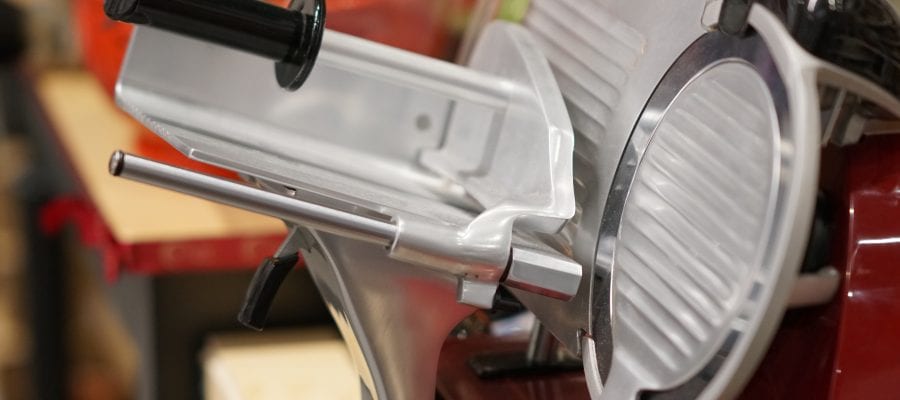
Our Review Process
Don't Waste Your Money is focused on helping you make the best purchasing decision. Our team of experts spends hundreds of hours analyzing, testing, and researching products so you don't have to. Learn more.
Our Picks For The Top Meat Slicers
With this meat slicer, you'll be able to adjust the thickness to produce thin slices for your children and thicker slices for yourself. The must-have kitchen tool is made using a durable aluminum and features removable parts for easy cleaning. The blades are constructed from a German high-carbon stainless steel, so you can be sure they're nice and ...
Economical OptionWhen shopping on a budget, you'll find this meat slicer is one of the most affordable.
Stunning is the best word to describe this meat slicer. It's made using a sharp steel blade that doesn't need to be sharped and offers a beautiful chromium finish. To use the slicer, all you need to do is hit the power switch and turn the knob to your desired thickness.
Doesn't Require SharpeningThis meat slicer also works well for prepping fruits and veggies.
In addition to beef, this meat slicer also works on cheese, vegetables and bread. The blade is removable for easy cleaning and the unit offers an adjustable thickness dial, so you can produce both thin and thick slices of your favorite foods.
Most VersatileEven if your beef is frozen, this meat slicer is able to work quickly to produce thin cuts.
There isn't anything you can't do with this powerful meat slicer. It features a 200-watt motor and comes with both smooth and serrated stainless steel blades. There's an adjustable thickness knob, a food-grade pusher and a set of anti-slip suction feet.
Compact and LightweightThis meat slicer is compact and lightweight, so you won't have any trouble moving it to a storage shelf when not in use.
Slice meats, cheeses and vegetables with ease when you have this meat slicer at your disposal. The unit features a large multipurpose 8.7-inch stainless steel serrated blade and a thickness control knob so you can switch from thin to medium to thick cuts. There's also a built-in food carriage that can easily be removed for quick cleaning.
Easy to CleanThe non-slip feet on this meat slicer keep it firmly planted in place while in use.
Buying Guide
There’s just something about having a meat slicer on your counter that says “chef at work.” It’s a staple on any deli counter, but it can be just as much of a time-saver at home — and no, you don’t need to be a chef to use one.
The basic design of the meat slicer hasn’t changed much over the years. Essentially, there’s a rotating steel blade with some sort of guard plate covering it. A carriage carries the meat (or other food) over the exposed sharp edge, cutting it into slices that drop on the other side. You can generally make those slices as thick or thin as you need with the use of a knob on the side that lowers or raises the carriage. Needless to say, it’s a vast improvement over the budget alternative of a simple knife, cutting board and elbow grease.
In the last few decades, we’ve seen electric slicers come into prevalence for home units as well as commercial use. Electric meat slicers make the whole process even easier, thanks to an electric motor that moves the carriage back and forth. Just put the food in, turn it on and it slices in seconds. Still, some prefer the control of a manual slicer, where the carriage is moved by hand — especially with tougher meats that might need additional pressure to cut.
While the catch-all name is “meat slicer,” these devices are by no means limited to one job. Depending on the household, meat slicing might not even be the primary use. They can be used to cut onions or tomatoes for a salad, cheese slices for sandwiches, homemade potato chips and more. You’ll get slices down to the last sliver of food, each one cut to a uniform thickness and as thin as you need. And since uncut veggies, meat and cheese cost much less than pre-sliced packages, you’re saving money as well as time.
There are some things you should consider before you buy, though. How often will you actually use it? Is it worth the time and expense, or can you use a mandolin for smaller jobs instead?
“If you do take the plunge, look for adjustable thickness control, easy cleaning, stainless steel parts, a safety guard to prevent inadvertent finger slicing and a good range of motion,” advises culinary expert Julie Chernoff, Les Dames d’Escoffier member, dining editor for Better magazine and food journalist.
Our Expert Consultant

Culinary Expert
Julie Chernoff is a long-time member of Les Dames d’Escoffier (past president of the Chicago Chapter, and current co-chair of the LDEI Legacy Awards Committee), the Association of Food Journalists (AFJ) and the International Association of Culinary Professionals.
Chernoff is the dining editor of Better, a lifestyle website and print magazine. Her journalism started in the test kitchens of Weight Watchers Magazine. She holds a BA in English from Yale University and is a graduate of the California Culinary Academy. She has spent the last few decades styling, photographing, teaching, developing recipes, editing, thinking and writing about food.
Why we recommend these meat slicers?
Products Considered
Products Analyzed
Expert Reviews Included
User Opinions Analyzed
The Best Bang For Your Buck
Anescra Compact Electric Meat Slicer
Key Takeawy
There isn't anything you can't do with this powerful meat slicer. It features a 200-watt motor and comes with both smooth and serrated stainless steel blades. There's an adjustable thickness knob, a food-grade pusher and a set of anti-slip suction feet.
What to Look For
- When you’re buying this appliance, the first thing you want to ask yourself is what you’ll be slicing. Despite the name, many households will use their meat slicer just as much for cutting veggies and cheese, if not more. If that’s the case, there might not be a need for a high-powered machine. In terms of wattage, meat slicers can range from a 120-watt motor to as much as 300 or more — though slicers in the latter range will be primarily for commercial use. If you’re expecting to slice roasts or ham on a regular basis, the higher wattage units might pay off in the long and short run, delivering an easier cut and higher durability.
- The same considerations apply when selecting a blade size. Most commercial slicers have a 7-inch diameter saw. That should be fine for vegetables, cheeses and most meats, but consider a 10″ blade if you’re cutting large slabs of roast.
- The next thing you’ll want to look at is the future home for your device. There’s no getting around the fact that slicers are fairly bulky, weighty pieces of machinery — and that’s for safety as much as anything else. But if counter space is at a premium, look for a compact model.
- Be on the lookout for cheap materials, too. For obvious reasons, you’re going to want a surface that won’t rust or stain easily, which is why most slicers of any quality are made out of stainless steel. Some may have plastic accessories such as blade guards or handles, but ideally, those will have some kind of waterproofing.
- Speaking of messes, you’re going to be cleaning that meat slicer after nearly every use. Make sure that process is as painless as possible, literally as well as figuratively. You’ll find that most slicers have detachable parts that might include the blade guard, blade, carriage and meat tray. Ideally, those parts can all be removed easily. If not, a sharp saw blade is not something you want to fumble with. You may also want to check which parts, if any, are dishwasher safe. It’s a feature that cuts down on hazards as well as cleaning time.
- Cleaning aside, how safe is your slicer in general? Meat slicers can be powerful time savers, but it’s best not to forget that you’re dealing with a whirling sharp blade. A good blade guard is key, but there are other safety features to consider, especially for those with young children in the house. An often-overlooked feature is the base. Are the legs of the slicer bare metal? Rubber? Suction-cupped? A secure, non-wobbly surface is crucial – especially for manual slicers – and can make sure there are no slips while you’re pushing your food across the carriage. Many models also incorporate a safety lever to lock the carriage when it’s not in use.
- Again, most every slicer has an adjustable thickness knob, but you’ll want a nice sharp blade for consistently thin cuts. Make sure you sharpen the blade at regular intervals, as directed by the manual. Some models include whetstones specific to their blade types.
You May Also Enjoy Our Other Reviews
- Robotic Vacuum
- Cordless Vacuums
- Air Mattress
- Drone
- Electric Razor
- Convertible Car Seat
- Infant Car Seat
- Dry Dog Food
- Carpet Cleaners
- Air Fryers
- Laptops
- Home Printers
- Wireless Router
- Streaming Device
- Electric Pressure Cooker
- Chromebook
- Television
- Digital Camera To Capture Special Moments On The Fly
- Smartwatch
- Upright Vacuum


